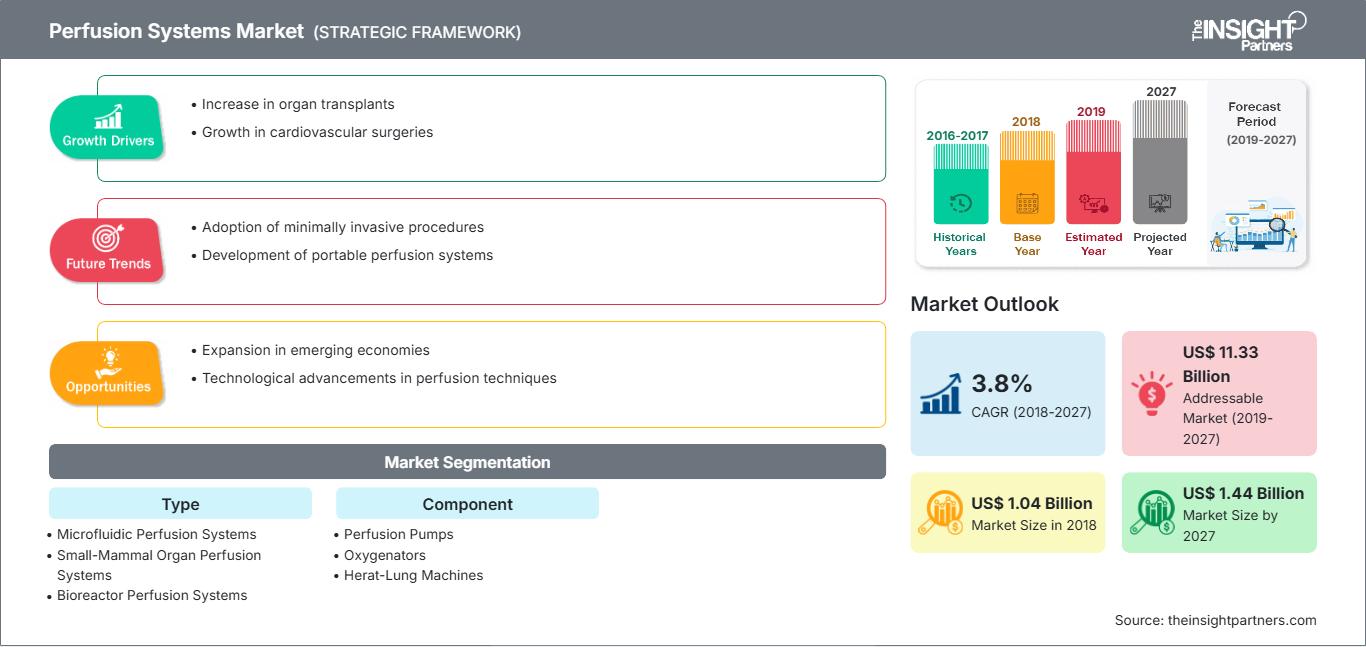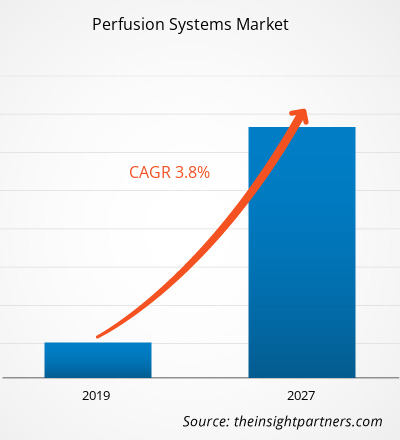2018 年灌注系统市场价值为 10.4475 亿美元,预计 2019 年至 2027 年的复合年增长率为 3.8%。
灌注是指液体通过循环系统或淋巴系统流向器官或组织,通常指将血液输送到组织中的毛细血管床。灌注以血液输送到组织的速率或单位时间每单位组织质量的血液量(血流量)来衡量。在大型手术期间,灌注必须由相关的医疗专业人员来维持和管理,而不是仅仅依靠身体的体内平衡。灌注系统市场的增长归因于心血管疾病患病率的上升、制药和生物技术行业的显著增长、器官移植需求的增加以及基于细胞的研究活动的兴起,这些因素在灌注系统市场的增长中发挥着至关重要的作用。然而,器官移植手术费用高昂、捐献者数量有限等挑战可能会在预测期内影响市场的增长。另一方面,新兴国家的技术发展为未来几年的市场增长提供了巨大的机遇。
预计灌注系统市场将在疫情后出现大幅增长。由于封锁、旅行禁令和企业倒闭,COVID-19 已影响到各国的经济和产业。COVID-19 危机使许多国家的公共卫生系统不堪重负,凸显了对卫生系统可持续投资的强烈需求。随着 COVID-19 疫情的进展,预计医疗保健行业的增长将下降。由于对体外诊断产品的需求增加以及全球研发活动的增加,生命科学领域蓬勃发展。然而,由于手术数量减少以及设备采购的推迟或延长,医疗技术和成像领域的销售额正在下降。此外,预计医疗保健专业人员的虚拟咨询将成为疫情后主流的医疗服务模式。随着远程医疗改变医疗服务方式,数字医疗将在未来几年继续蓬勃发展。此外,临床试验的中断以及随之而来的药物上市延迟也有望为未来完全虚拟试验铺平道路。预计mRNA等新技术将会出现并改变制药行业,未来几年市场也将见证更多的垂直整合和合资企业。
市场洞察:灌注系统在医疗保健领域的应用日益广泛,推动灌注系统市场增长
心血管疾病 (CVD) 是心脏和血管疾病,包括脑血管疾病、冠心病、风湿性心脏病和其他疾病。导致死亡和困难的一些主要因素是吸烟、不健康饮食和缺乏运动,这些都会增加心脏病发作和中风的风险。心血管疾病是全球最大的死亡原因,与任何其他疾病相比,它影响的人数更多。除了生活方式和习惯外,老年人更容易患心血管疾病。随着人口老龄化,血管结构和功能通常会发生改变,从而增加罹患心血管疾病的风险。
自定义此报告以满足您的要求
您将免费获得任何报告的定制,包括本报告的部分内容,或国家级分析、Excel 数据包,以及为初创企业和大学提供超值优惠和折扣
灌注系统市场: 战略洞察

- 获取本报告的主要市场趋势。这个免费样本将包括数据分析,从市场趋势到估计和预测。
您将免费获得任何报告的定制,包括本报告的部分内容,或国家级分析、Excel 数据包,以及为初创企业和大学提供超值优惠和折扣
灌注系统市场: 战略洞察

- 获取本报告的主要市场趋势。这个免费样本将包括数据分析,从市场趋势到估计和预测。
心血管疾病在世界范围内的患病率正在上升。导致人群患上心血管疾病的关键因素是:心血管疾病是全球死亡的主要原因。根据美国心脏病学会的数据,心血管疾病在美国造成近80万人死亡,大约占死亡人数的三分之一。冠心病(CHD)是造成大多数心血管疾病死亡的原因,其次是卒中和心力衰竭。超过9000万美国人被诊断出患有心血管疾病。此外,数据显示,在全球范围内,心血管疾病约占所有死亡人数的31%,预计到2030年,心血管疾病的费用将达到约10440亿美元。
在欧洲,心血管疾病(CVD)每年导致390万人死亡,在欧盟,心血管疾病导致的死亡人数超过180万人。心血管疾病(CVD)占欧洲总死亡人数的45.0%,占欧盟总死亡人数的37.0%。心血管疾病是所有国家男性和女性死亡的主要原因。因此,在心脏手术过程中,需要灌注系统来绕过心肺功能,并帮助维持血液循环和身体的氧含量。因此,由于各地区和各国心血管疾病的患病率不断上升,预测期内,用于治疗心血管疾病的灌注系统的需求可能会增加市场规模。
制药和生物技术行业的显著增长也推动了灌注系统市场的发展。在过去的几年中,制药和生物技术行业发展异常迅速。慢性和急性疾病患病率的上升令人担忧,对药物、治疗剂、疫苗、抗生素等的需求也日益增加。技术进步帮助制造商轻松地提高生产效率。这些制造商及其与合同研究组织 (CRO) 的联盟正面临着巨大的医疗保健挑战,包括新药物、新疗法、数字化进程和不断变化的法规。此外,老年人口的增长也导致医疗保健条件的恶化。根据世界卫生组织的数据,全球人口每年增长 1.24%,导致老年人口数量增加。
世卫组织还预测,到 2030 年,65 至 80 岁人口的比例将上升到 28%,而 2000 年这一比例为 22%。此外,根据 Torreya Economical Model 2017 发布的调查报告,到 2017 年,制药业的规模比之前的估计高出 30%,是全球经济价值增长的五大行业之一。
此外,全球制药、生物制药和生物技术领域的初创企业数量也在不断增加。这些公司正在开发创新药物和治疗产品,并得到了各国政府的支持。因此,无论是初创企业还是成熟企业,药品和其他治疗产品的生产都呈现出巨大的增长。药品和治疗产品的生产需要灌注系统,而灌注系统则需要生产从生物源获得的原材料。生物技术公司也从事农业、食品饮料和其他行业的原材料生产。与制药行业相比,生物技术公司对灌注系统的需求更大。因此,由于这些因素,灌注系统市场在未来几年可能会蓬勃发展。器官移植是当患者的器官完全停止功能时进行的外科手术。器官移植通常针对心脏、肝脏和肾脏等器官进行。然而,慢性病病例的增加导致对其他器官(例如肺、胰腺、角膜和血管组织)的移植需求也随之增加。器官移植被认为是现代医疗行业的一大进步。
导致心脏、肺、肝、肾和其他器官功能损害的慢性疾病的增多导致器官移植数量的增加。世界各地的器官移植手术都在增加。例如,在西班牙,进行了大约 5,260 例移植手术,其中近 3,200 例为肾移植手术,约 1,200 例为肝移植手术。心脏移植手术约有 300 例,肺移植手术近 360 例。公私合作伙伴关系在移植协调员的协助下为器官移植的改进做出了巨大贡献。发展中国家和发达国家都展示了大量的器官移植手术。例如,印度和新加坡等发展中国家正在成为亚太地区的医疗旅游目的地。这些国家在提供更好、更先进的医疗服务方面正在不断发展。
根据2017年美国国家慢性肾脏病情况说明书,美国约有3000万人患有慢性肾脏病。同样,根据美国国家糖尿病、消化和肾脏疾病研究所的数据,近661,000名美国人患有肾衰竭,其中468,000名患者正在接受透析治疗,约193,000名患者接受了肾移植。因此,发病率的上升可能会导致未来几年肾脏移植的需求增加。同样,据估计,心脏病患者的增长也将在未来推动市场发展。因此,器官移植需求的增加是灌注系统市场的主要驱动因素之一。
慢性病的增多,生物技术应用的优势正在促进基于细胞的广泛研究活动。基于细胞的分析有助于理解生物体生物学的挑战。这些研究有助于理解疾病的发生过程及其复杂性。细胞分析有助于理解细胞信号传导、增殖、凋亡、细胞遗传学、神经学、癌症等方面。
细胞分析广泛应用于制药、生物技术行业、研究机构和学术研究机构。制药和生物制药行业需要高效地将药物商业化。因此,细胞分析在制药和生物技术行业是灌注系统发展的驱动因素。
细胞分析也广泛用于合同研究机构的临床试验研究和其他流程。癌症等慢性疾病和其他遗传相关研究正在推动细胞研究的发展。例如,Charles River 提供人类原代细胞分析服务,该公司发表的一篇文章指出,细胞分析在未来可能会持续发展。文章指出,细胞分析有助于药物研发,因为体外和体内的相关性在药物研发中起着至关重要的作用。因此,日益增长的细胞研究活动可能会在预测期内推动灌注系统的发展。
基于类型的洞察
就类型而言,灌注系统市场细分为微流体灌注系统、小型哺乳动物器官灌注系统、生物反应器灌注系统、重力或压力驱动灌注系统。2018年,按类型划分,生物反应器灌注系统占据了灌注系统市场的最大份额,为44.3%。
基于组件的洞察
根据组件,灌注系统市场细分为灌注泵、氧合器、心肺机、监测系统、插管等。预计在预测期内,氧合器细分市场的复合年增长率将达到 4.4%。
灌注系统市场参与者正在采用产品发布和扩张策略,以满足全球不断变化的客户需求,这也使他们能够在全球范围内维护自己的品牌名称。
灌注系统市场区域洞察
The Insight Partners 的分析师已详尽阐述了预测期内影响灌注系统市场的区域趋势和因素。本节还讨论了北美、欧洲、亚太地区、中东和非洲以及南美和中美洲的灌注系统市场细分和地域分布。
灌注系统市场报告范围
| 报告属性 | 细节 |
|---|---|
| 市场规模 2018 | US$ 1.04 Billion |
| 市场规模 2027 | US$ 1.44 Billion |
| 全球复合年增长率 (2018 - 2027) | 3.8% |
| 历史数据 | 2016-2017 |
| 预测期 | 2019-2027 |
| 涵盖的领域 |
By 类型
|
| 覆盖地区和国家 | 北美
|
| 市场领导者和主要公司简介 |
|
灌注系统市场参与者密度:了解其对业务动态的影响
灌注系统市场正在快速增长,这得益于终端用户需求的不断增长,而这些需求的驱动因素包括消费者偏好的不断变化、技术进步以及对产品优势的认知度不断提高。随着需求的增长,企业正在扩展其产品线,不断创新以满足消费者需求,并利用新兴趋势,从而进一步推动市场增长。

- 获取 灌注系统市场 主要参与者概述
灌注系统市场 — 按类型
- 微流体灌注系统
- 小型哺乳动物器官灌注系统
- 生物反应器灌注系统
- 重力或压力驱动灌注系统
灌注系统市场 — 按组件
- 灌注泵
- 氧合器
- 人工心肺机
- 监测系统
- 套管
- 其他
灌注系统市场 —按地理位置
北美洲
- 美国
- 加拿大
- 墨西哥
欧洲
- 法国
- 德国
- 意大利
- 英国
- 西班牙
- 其他地区欧洲
亚太地区(APAC)
- 中国
- 印度
- 韩国
- 日本
- 澳大利亚
- 亚太地区其他地区
中东和中东地区非洲 (MEA)
- 南非
- 沙特阿拉伯
- 阿联酋
- MEA 其他地区
南美洲和中美洲 (SCAM)
- 巴西
- 阿根廷
- SCAM 其他地区
公司简介
- REPLIGEN CORPORATION
- Merck KGaA
- Ala Scientific Instruments, Inc.
- XVIVO Perfusion
- Medtronic
- XENIOS AG (Fresenius Medical Care AG & Co. KGaA)
- Getinge AB
- TERUMO CORPORATION
- LivaNova PLC
- Sartorius AG
- Harvard Bioscience
- RAND
- Sanisure (Sani-Tech West, Inc.)
- AutoMate Scientific, Inc
- Jobst Technologies GmbH
- APD(高级灌注诊断)
- Spectrum Medical、Transonic Systems Inc
- OrganOx
- ISCHEMAVIEW, INC
- CESCO BIOENGINEERING CO., LTD
- 历史分析(2 年)、基准年、预测(7 年)及复合年增长率
- PEST和SWOT分析
- 市场规模、价值/数量 - 全球、区域、国家
- 行业和竞争格局
- Excel 数据集
近期报告
客户评价
购买理由
- 明智的决策
- 了解市场动态
- 竞争分析
- 客户洞察
- 市场预测
- 风险规避
- 战略规划
- 投资论证
- 识别新兴市场
- 优化营销策略
- 提升运营效率
- 顺应监管趋势




















 获取免费样品 - 灌注系统市场
获取免费样品 - 灌注系统市场